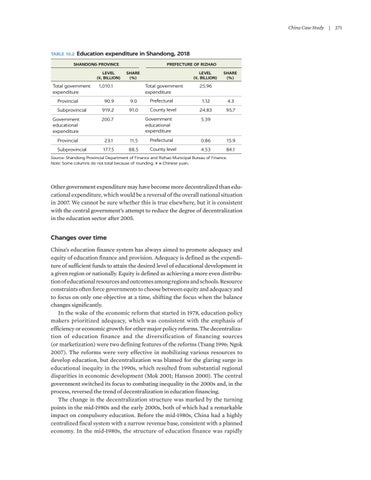China Case Study | 271
TABLE 10.2 Education
expenditure in Shandong, 2018
SHANDONG PROVINCE LEVEL (¥, BILLION)
Total government expenditure Provincial
PREFECTURE OF RIZHAO SHARE (%)
1,010.1 90.9
LEVEL (¥, BILLION)
Total government expenditure
SHARE (%)
25.96
9.0
Prefectural
1.12
4.3
91.0
County level
24.83
95.7
Government educational expenditure
5.39
Subprovincial
919.2
Government educational expenditure
200.7
Provincial
23.1
11.5
Prefectural
0.86
15.9
177.5
88.5
County level
4.53
84.1
Subprovincial
Source: Shandong Provincial Department of Finance and Rizhao Municipal Bureau of Finance. Note: Some columns do not total because of rounding. ¥ = Chinese yuan.
Other government expenditure may have become more decentralized than educational expenditure, which would be a reversal of the overall national situation in 2007. We cannot be sure whether this is true elsewhere, but it is consistent with the central government’s attempt to reduce the degree of decentralization in the education sector after 2005.
Changes over time China’s education finance system has always aimed to promote adequacy and equity of education finance and provision. Adequacy is defined as the expenditure of sufficient funds to attain the desired level of educational development in a given region or nationally. Equity is defined as achieving a more even distribution of educational resources and outcomes among regions and schools. Resource constraints often force governments to choose between equity and adequacy and to focus on only one objective at a time, shifting the focus when the balance changes significantly. In the wake of the economic reform that started in 1978, education policy makers prioritized adequacy, which was consistent with the emphasis of efficiency or economic growth for other major policy reforms. The decentralization of education finance and the diversification of financing sources (or marketization) were two defining features of the reforms (Tsang 1996; Ngok 2007). The reforms were very effective in mobilizing various resources to develop education, but decentralization was blamed for the glaring surge in educational inequity in the 1990s, which resulted from substantial regional disparities in economic development (Mok 2001; Hanson 2000). The central government switched its focus to combating inequality in the 2000s and, in the process, reversed the trend of decentralization in education financing. The change in the decentralization structure was marked by the turning points in the mid-1980s and the early 2000s, both of which had a remarkable impact on compulsory education. Before the mid-1980s, China had a highly centralized fiscal system with a narrow revenue base, consistent with a planned economy. In the mid-1980s, the structure of education finance was rapidly






